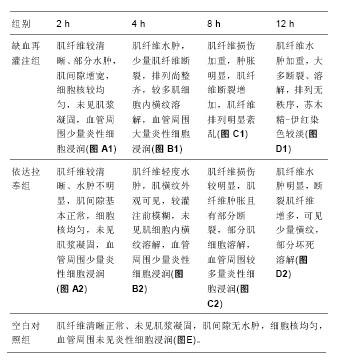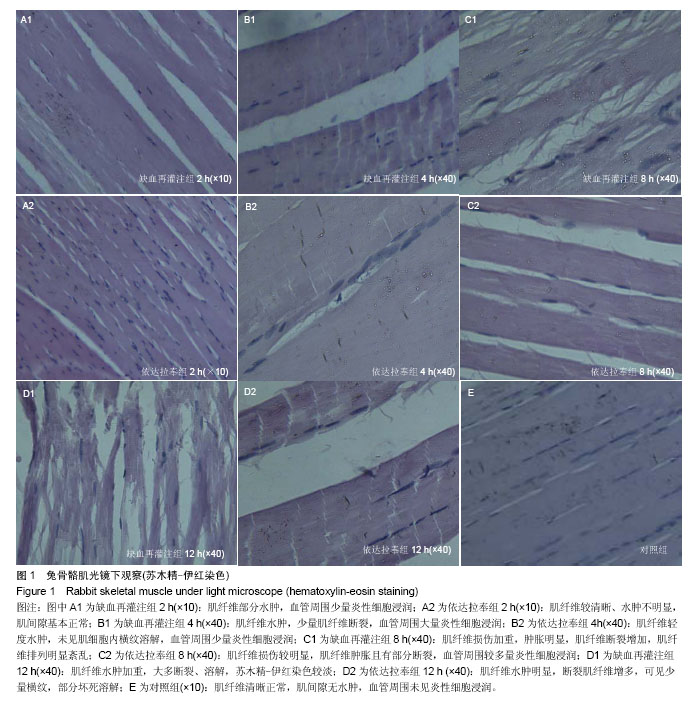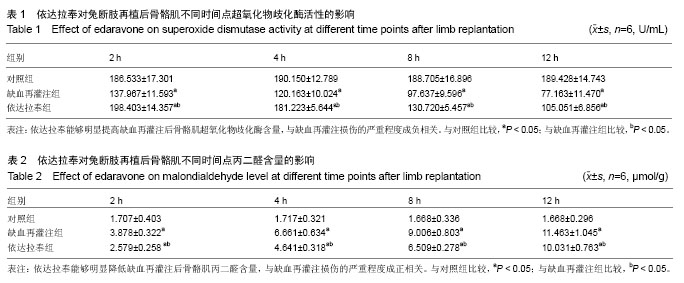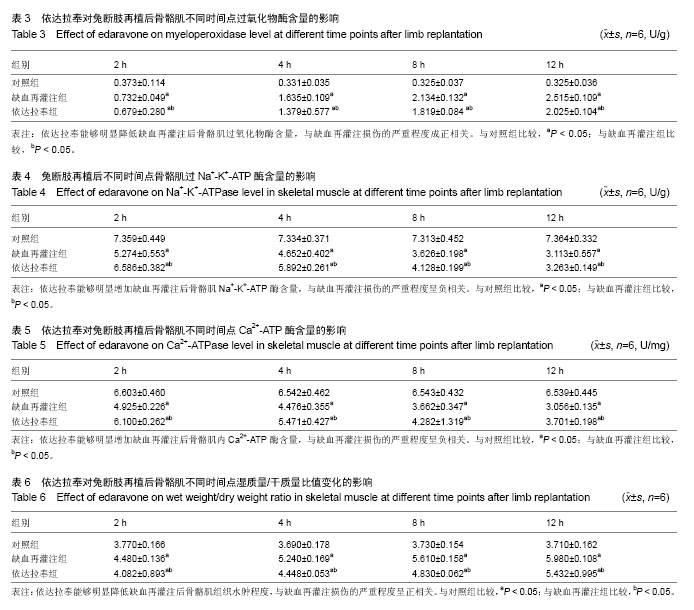| [1] 张震宇,杨卫良,王立峰,等.断肢再植肌组织缺血再灌注损伤的细胞凋亡及Bax、Bcl-2的表达[J].哈尔滨医科大学学报,2006,40 (5):371-374.
[2] 王悦书,王国君,张弘,等.缺血兔骨骼肌变性的组织学研究[J].吉林大学学报(医学版),2002,28(4):366-368.
[3] 张志新,王国君,路来金,等.生物发光法短时内判断温缺血断肢再植时限的实验研究[J].白求恩医科大学学报,2000,26(5): 496-498.
[4] Yoshida H, Metoki N, Ishikawa A, et al. Edaravone improves the expression of nerve growth factor in human astrocytes subjected to hypoxia/reoxygenation. Neurosci Res. 2010; 66(3):284-289.
[5] Fu JQ, Wang DF, Liu H, et al. A comparative study on the protection effect of nerve growth factor and edaravone pretreatment against cerebralischemia/reperfusion injury. Zhongguo Wei Zhong Bing Ji Jiu Yi Xue. 2010;22(4): 226-229.
[6] Srinivasan K, Sharma SS. Edaravone Offers Neuroprotection in a Diabetic Stroke Model via Inhibition of Endoplasmic Reticulum Stress. Basic Clin Pharmacol Toxicol. 2011;58(6): 1742-1749.
[7] Connell BJ, Saleh MC, Kucukkaya I, et al. UPEI-300, a conjugate of lipoic acid and edaravone, mediates neuroprotection in ischemia/reperfusion. Neurosci Lett. 2014 Jan 3. pii: S0304-3940(13)01141-5.
[8] Yao N, Wang DF, Song X, et al. Neuroprotective effects of combined pretreatment with edaravone and propofol on neonatal rat cerebral cortical neurons with ischemia/ reperfusion injury in vitro. Zhongguo Wei Zhong Bing Ji Jiu Yi Xue. 2012;24(5):286-289.
[9] Jiao L, Zhang J, Li Z, et al. Edaravone alleviates delayed neuronal death and long-dated cognitive dysfunction of hippocampus after transient focal ischemia in Wistar rat brains. Neuroscience. 2011;19;182:177-183.
[10] Herlambang B, Orihashi K, Mizukami T, et al. New method for absolute spinal cord ischemia protection in rabbits. J Vasc Surg. 2011;54(4):1109-1116.
[11] Ergenoglu M, Erba? O, Akdemir A, et al. Attenuation of ischemia/reperfusion-induced ovarian damage in rats: does edaravone offer protection? Eur Surg Res. 2013;51(1-2): 21-32.
[12] Kara M, Daglioglu YK, Kuyucu Y, et al. The effect of edaravone on ischemia-reperfusion injury in rat ovary. Eur J Obstet Gynecol Reprod Biol. 2012;162(2):197-202.
[13] Shimoda M, Iwasaki Y, Okada T, et al. Edaravone inhibits apoptosis caused by ischemia/reperfusion injury in a porcine hepatectomy model. World J Gastroenterol. 2012;18(27): 3520-3526.
[14] Yamamura M, Miyamoto Y, Mitsuno M, et al. Edaravone protects against tissue damage in the lung and kidney induced by myonephropathic metabolic syndrome. Int J Angiol. 2010;19(1):e38-40.
[15] Kikuchi K, Tancharoen S, Takeshige N, et al. The efficacy of edaravone (radicut), a free radical scavenger, for cardiovascular disease. Int J Mol Sci. 2013;14(7): 13909-13930.
[16] Zhang W, Guo Y, Yu S, et al. Effects of edaravone on the expression of β-defensin-2 mRNA in lung tissue of rats with myocardial ischemiareperfusion. Mol Med Rep. 2013;7(5): 1683-1687.
[17] Zhang GM, Wang Y, Li XY, et al. Pharmacological postconditioning with lactic acid and low dose edaravone could attenuate myocardialreperfusion injury through mitochondrial pathway. Zhonghua Xin Xue Guan Bing Za Zhi. 2013;41(8):647-653.
[18] Yamamura M, Miyamoto Y, Mitsuno M, et al. Edaravone reduces mitochondrial damage due to reperfusion injury following leg ischemia in rats. Int J Angiol. 2010;19(4):e129-131.
[19] Yamamura M, Miyamoto Y, Mitsuno M, et al. Edaravone Suppresses Reperfusion Injury following Leg Ischemia in Rats: A Transmission Electron Microscopic Study. Int J Angiol. 2013;22(4):267-270.
[20] 段永壮,王增涛,钟世镇,等.依达拉奉对深低温保存大鼠断肢再植后缺血再灌注损伤的影响.中国组织工程与临床康复, 2007, 11(8):1416-1419.
[21] Hori K, Tsujii M, Iino T, et al. Protective effect of edaravone for tourniquet-induced ischemia-reperfusion injury on skeletal muscle in murine hindlimb. BMC Musculoskelet Disord. 2013; 14:113
[22] Liu S, Li R, Ni X, et al. Perfluorocarbon-facilitated CNS oxygen toxicity in rats: reversal by edaravone. Brain Res. 2012;1471:56-65.
[23] Gao Y, Ding XS, Xu S, et al. Neuroprotective effects of edaravone on early brain injury in rats after subarachnoid hemorrhage.Chin Med J. 2009;122(16):1935-1940.
[24] Zhang P, Li W, Li L, Wang N, et al. Treatment with edaravone attenuates ischemic brain injury and inhibits neurogenesis in the subventricular zone of adult rats after focal cerebral ischemia and reperfusion injury. Neuroscience. 2012;201: 297-306.
[25] Zhang N, Miki KK, Ryota T, et al.Edaravone reduces early accumulation of oxidative products and sequential inflammatory reponses after transient focal ischemia in mice brain.Stroke. 2005;36(3):2220-2225.
[26] Irie H, Kato T, Ikebe K, et al. Antioxidant effect of MCI-186,a new free radical scavenger,on ischemia-reperfusion injury in a rat hindlimb amputation model.J Surg Res. 2004;120(2): 312-319.
[27] Blaisdell FW.The pathophysiology of skeletal muscle ischemia and the reperfusion syndrome:a review. Cardiovasc Surg. 2002;10(6):620-630.
[28] Sheu EG, Oakes SM, Ahmadi-Yazdi C,et al. Restoration of skeletal muscle ischemia-reperfusion injury in humanized immunodeficient mice. Surgery. 2009;146(2):340-346.
[29] ]Serviddio G,di Venosa N,Fedeeici A,et al. Brief hypoxia before normoxic reperfusion (postconditioning) protects the heart against ischemia-reperfusion injury by preventing micochonndria peroxyde production and glutahione depletion. FASEB J.2005;19(3)345-361.
[30] Bolte CS,Liao S,Gross GJ,et al.Rrmote preconditioning- endocrine factors in organ protection against ischemic injury.Endocr Metab Immune Disord Drug Targets. 2007;7(3): 167-175. |



